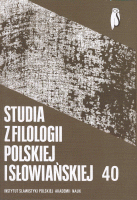Koncepcja językowego obrazu świata w programie slawistycznych badań porównawczych
A Concept of the Linguistic Image of the World in the Programme of Slavistic Comparative Studies
Author(s): Jerzy BartmińskiSubject(s): Language studies
Published by: Instytut Slawistyki Polskiej Akademii Nauk
Summary/Abstract: The author presents a programme of comparative research adopting the concept of linguistic image of the world, which has become popular in recent years, in particular among the linguists in Poland and in Russia. The author discusses three ways of solving the key issue conditioning effectiveness of such research being the tertium comparationis (TC): starting from the name (then the words are combined with their meanings, for example the word dunaj in the Slavonic languages), starting from an object (a thing – then the question refers to the ways of naming, for instance the names of a rainbow in various languages represent the varying conceptualizations) and starting from the notions connecting names and objects (for instance the notions of ‘the homeland’, ‘state’, ‘fate/plight’, ‘citizen’ etc. in various languages). It is possible to assume TC as the starting point for particular notions (“concepts”) when comparisons within certain cultural circles are made. For example, for the Mediterranean (European) circle, when compared are concepts like the Latin-originating ‘patria’, ‘civitas’, ‘fortuna’, and Greek ‘polites’. For the contrastive research involving languages which are not similar and typologically distant from one another, it seems that adopting the semantic metalanguage is the most appropriate – and a good example has been worked out in this by Anna Wierzbicka. At the higher level of comparisons, above lexical level, comparative analyses of entire lexical-semantic fields are possible (like colours, genders of speech, feelings and emotions and so on). Further, it is possible to confront the superior semiotic oppositions of the type masculine/feminine, ‘ours’/alien etc. The author proposes to start comparative research first the etnonyms – and more precisely: national autostereotypes and heterostereotypes – as well as the language pictures of the time, place, values and means of expression (speech genders). The author provides a list of a number of names of values (freedom and tolerance, independence and separatism, globalism and regionalism, patriotism and nationalism etc.) that he considers worthy being researched upon in the first place due to the fact that those create real barriers in the cross-cultural communication.
Journal: Studia z Filologii Polskiej i Słowiańskiej
- Issue Year: 2005
- Issue No: 40
- Page Range: 259-280
- Page Count: 22
- Language: Polish

